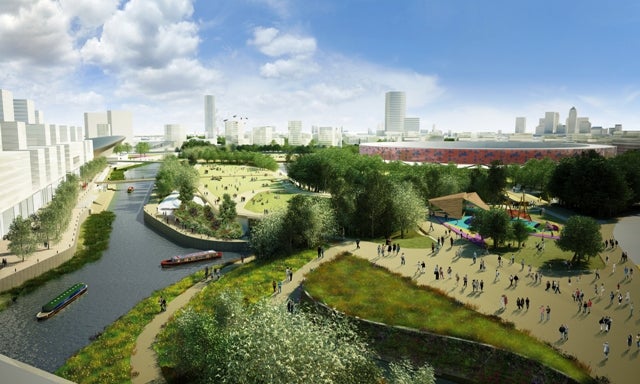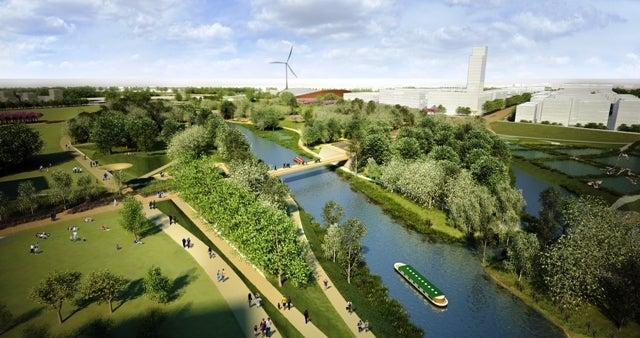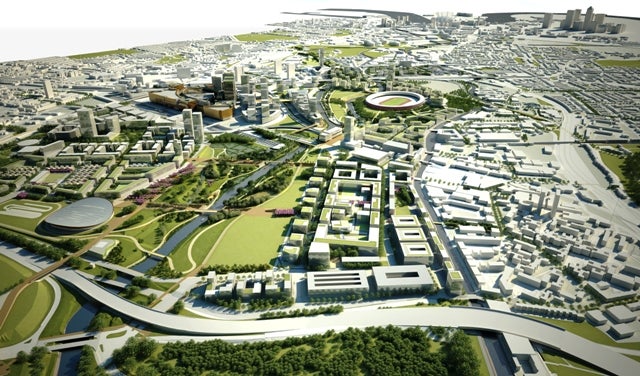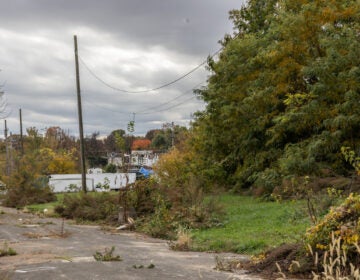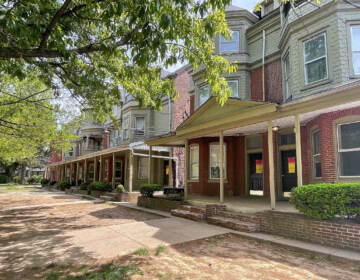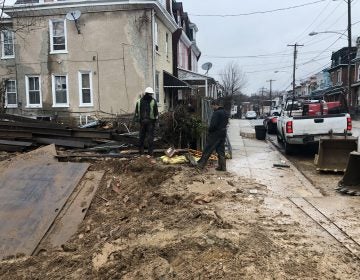London’s Olympic organizers taking the long view
March 29, 2010
By Robert DiGiacomo
For PlanPhilly
While it may seem like the Vancouver Olympics just ended yesterday, the clock is ticking for organizers of the upcoming summer games in London to get ready for the 2012 event.
This goes beyond developing the Olympic Park and planning the games themselves. Organizers also are deep into deciding what will happen to the new buildings and infrastructure after the closing ceremonies.
The London committee’s legacy plan –– a blueprint for how the Olympic venues and infrastructure will be used in the future –– helped win the city the games in July, 2005. Post-game plans now call for a transit-oriented mix of housing, retail and office uses for the site, which also will include public green spaces and recreational and sporting facilities.
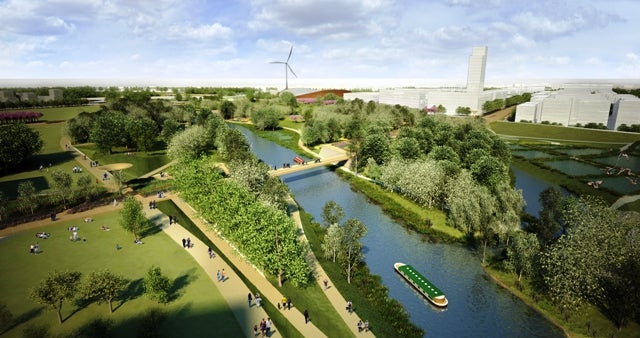
A view of what Olympic Park might look like in 2040.
The effort to determine the site’s post-games use has a special link to Philadelphia, as Andrew Altman, a native son and the city’s former deputy mayor for planning and economic development and director of commerce, is leading the Olympic Park Legacy Company.
Altman, during an interview in mid-January a London hotel café, described the opportunity to shape the Olympic park’s future as “urban development on steroids.” (Read more about Altman, and his take on his Philadelphia tenure, here.)
“Because it is a signature project, it has huge reputational value for the U.K. and enormous significance to London,” Altman says. “It’s a huge public investment of 9 billion pounds [$13.4 billion]. The stakes are incredibly high and the spotlight is incredibly high.”
Construction at the sprawling, 600-acre former industrial site is scheduled to wrap early next year, to allow time for the venues to be tested and tweaked during time-trials in August, 2011.
I got a chance in mid-January to see for myself how the entire project was faring.
At that time, the steel was up for the Olympic stadium and other major sporting venues, and the Olympic village and media center were nearly complete.
During my 30-minute bus tour, the volunteer guide emphasized the venues’ eventual re-use almost as much as their original purpose.
Still, it took some imagination to reconcile the muddy and slightly chaotic scene –– populated by a vast army of workers, huge stores of materials and the requisite battery of heavy equipment –– with the shiny new facilities recently showcased in Vancouver and the promise of the new community touted by London’s Olympic planners.
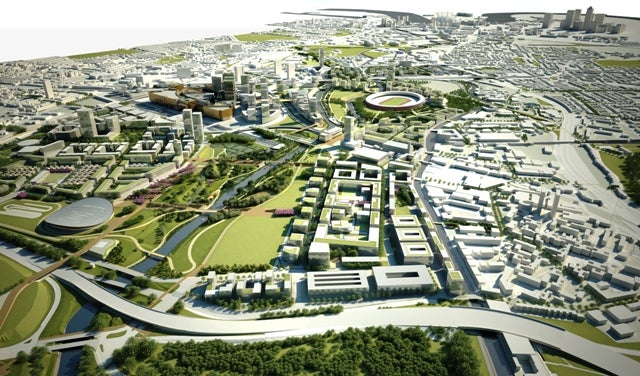
Another view of the potential future for the Olympic site, at Canary Warf.
As with most Olympic cities, London wants its games to serve as a kind of supercharged economic development tool. The communities adjoining the site could really use the boost, as they suffer from some of the country’s highest unemployment rates, as well as serious health and social issues tied to poverty.
John Armitt, chairman of the Olympic Delivery Authority, which is developing the Olympic Park, believes the chance to remake a great swath of the city more than justifies the enormous resources being committed to the project.
“I think it’s very difficult for any country or city…to justify that level of expenditure for a four-week party,” Armitt says. “It’s very important that you’re able to demonstrate the facilities are designed with the legacy stake in mind, so that the city is getting a benefit, not only from the enjoyment of the Games and people coming to a city.
He adds: “It’s an opportunity to take this area that probably never would have seen this level of investment…and create a much nicer environment for people to work, live and play.”
While Altman’s company isn’t scheduled to take control of the Olympic parcel until the year after the games, the blueprint for the site is taking shape.
The park is located within the Thames Gateway, an urban redevelopment zone that encompasses land around the Thames River and Estuary.
Prior to starting any construction, the Olympic Delivery Authority conducted a rigorous environmental clean up that entailed removing tons of contaminated soil, cleaning it and returning 80 percent of it to the site.
The ODA also has spent some 500 million pounds, or about $744 million, on rail, telecommunications and other infrastructure improvements. Existing transit stations, which are part of the city’s vast underground and overground network, also have been modified to allow for high-speed connections to other parts of England and the potential to add a high-speed link to Paris.
A key commercial anchor adjacent to the Olympic site is a 1.9 million sq.-ft. mall being built by Westfield Shopping Centres that will be the largest indoor mall in Europe when it opens in 2011. Westfield Stratford City will resemble a splashier version of the King of Prussia Mall, with three anchor stores, 300 specialty shops and restaurants, and a digital cinema multiplex.
The mall is the first of what’s hoped will be multiple public and private sector developments on and around the site.
Plans listed on Westfield’s Web site also call for the construction of another 1 million square feet in retail and leisure space, 1.3 million square feet of hotels and a 6.6 million square foot commercial district. According to Altman’s Legacy Company, some 10,000 housing units also are on the drawing board.
What other developments transpire on the site depends largely on a comprehensive master plan being crafted in consultation with three planning firms –– AECOM, Allies and Morrison, and Kees Christiaanse Architects & Planners, aka KCAP –– as well as larger economic forces. The plan is expected to be finalized in early 2011.
“The goal of all of this is to take something pretty extraordinary –– the park, the sporting legacy, the largest open mall in Europe –– to take those building blocks and start to build a city,” Altman says.
The site faces a high hurdle of being judged against London’s extensive network of parks, which provide lively green anchors to the city’s commercial and residential districts.
According to Altman, for the Olympic site to succeed as a new live-work area, the park also must be a winner.
“The whole idea is that this will be one of the great parks in London,” Altman says. “It’s the largest park that’s been built in London for over 100 years. One of the fantastic things about coming to London as a city are the fantastic and open spaces of London and the relationships of the parks to the neighborhood. From a planning perspective, you can’t get a better model of a place that functions extraordinarily well.”
To keep the Olympic momentum going, Altman sees major events –– including the possibility of staging the 2018 World Cup there –– as key to satisfying the public’s expectations and wooing private investment.
With community use in mind, the Olympic stadium has been designed so eventually it can be downsized from 80,000 seats to a more manageable 25,000. However, the Legacy Company, which has issued a request for proposals for the venue, will not make the final call on its second life – or seating configuration – until March 2011.
The designs for the swimming venue and velodrome also allow for them to be converted for community access. Other temporary venues, such as the basketball arena, will be razed.
Two Olympic facilities that were nearly built at the time of my tour –– the “village” that will house athletes and the 1 million square foot media center –– have their next uses set: The former will become a 2,800-unit mid-rise apartment complex and the latter, which has space for 20,000 media types, will be an office building.
Beyond the “hard legacy” of what happens to the venues, London organizers also hope to leave behind a significant “soft legacy” by providing training and work opportunities to area residents.
“When you talk about transformative projects, this really is the definition of that,” Altman says.
He feels “fortunate” to be a part of it. “I never lived in Europe and I’m learning a whole way of planning and development and city building. The way that planning is looked [in terms of] design and sustainability is very progressive and very interesting and challenges your assumptions.”
Contact Robert DiGiacomo at robcomo@aol.com
Check out his new online magazine, The City Traveler, at www.thecitytraveler.com
WHYY is your source for fact-based, in-depth journalism and information. As a nonprofit organization, we rely on financial support from readers like you. Please give today.



